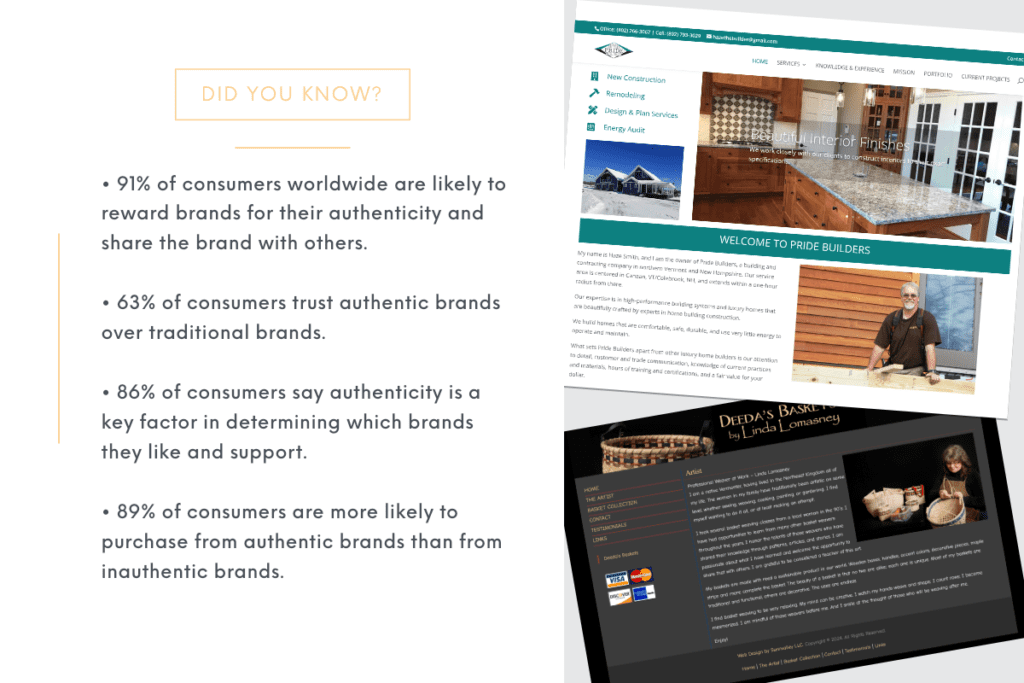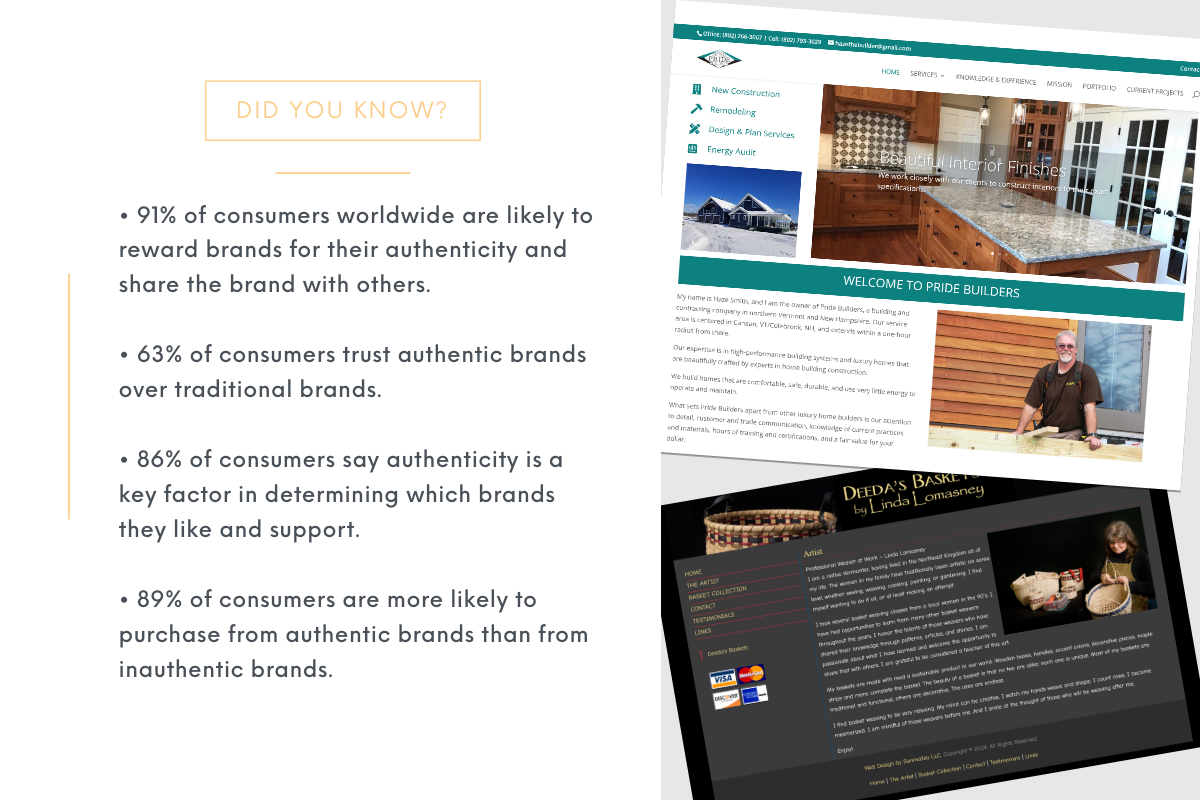Authenticity is king and has emerged as a powerful brand differentiator. Whether you’re building a personal brand or a business brand, authenticity is what will make you stand out and connect with your audience on a deeper level. But what does it mean to be authentic? How can you ensure that your brand is genuinely authentic? This blog post will explore the essence of branding authenticity, how to create it, and provide real-world examples to inspire you.

Stats about branding authenticity from 2024 Wordmetrics: https://worldmetrics.org/brand-authenticity-statistics
What is Branding Authenticity?
Branding authenticity refers to the practice of being true to your brand’s core values, mission, and promises. It’s about presenting a brand identity that is honest, transparent, and reflective of your true self or your business’s purpose. Authentic brands are those that consumers believe are genuinely committed to their values, not just using them as a marketing tactic.
Consumers are increasingly skeptical of polished, overly-produced branding efforts, authenticity is what humanizes your brand and creates trust. Authenticity doesn’t mean being perfect; it means being real, relatable, and transparent about who you are, what you do, and why you do it.
Why is Authenticity Important?
Consumers today are bombarded with options, and trust has become a key factor in their decision-making process. Authentic brands build trust by demonstrating integrity, consistency, and a genuine commitment to their promises. This trust translates into customer loyalty, advocacy, and long-term success.
Moreover, authentic branding can help differentiate your brand in a crowded market. It allows you to connect with your audience on an emotional level, fostering a sense of community and belonging. When customers feel like they share values with a brand, they are more likely to support it and spread the word to others.
How to Create an Authentic Brand
Creating an authentic brand involves more than just crafting a catchy tagline or a visually appealing logo. It requires a deep understanding of who you are as a brand and a commitment to reflecting that identity consistently across all touchpoints.
1. Know Your Core Values
The foundation of any authentic brand lies in its core values. These values are the principles that guide your brand’s actions and decisions. To create an authentic brand, start by identifying what truly matters to you or your business. Are you committed to sustainability, innovation, customer service, or community involvement? Your core values should be evident in everything you do, from the products you offer to the way you interact with customers.
2. Be Transparent
Transparency is a critical component of authenticity. Consumers appreciate brands that are open about their processes, challenges, and successes. Whether it’s being honest about your product’s limitations, sharing the story behind your business, or communicating openly during a crisis, transparency builds trust and reinforces your brand’s authenticity.
3. Embrace Your Uniqueness
Authentic brands are unapologetically unique. They don’t try to mimic competitors or follow the latest trends just because everyone else is doing it. Instead, they focus on what makes them different and lean into those differences. Whether it’s a quirky personality, a unique product offering, or an unconventional approach to customer service, embracing your uniqueness sets you apart and enhances your authenticity.
4. Consistency is Key
Consistency across all branding elements—visual identity, messaging, tone, and customer experience—is crucial to maintaining authenticity. Your brand should present a cohesive and consistent identity across all platforms and interactions. This consistency reassures customers that what they see is what they get, fostering trust and loyalty.
5. Tell Your Brand Story
Every brand has a story, and telling it authentically is a powerful way to connect with your audience. Your brand story should be more than just a timeline of events; it should convey the passion, purpose, and values that drive your brand. Whether you’re sharing the origins of your business, the challenges you’ve overcome, or the vision you have for the future, an authentic brand story resonates with customers and deepens their connection to your brand.
6. Engage with Your Audience
Authenticity is a two-way street. It’s not just about presenting your brand authentically but also about engaging authentically with your audience. This means listening to feedback, responding to comments, and fostering genuine interactions with your customers. Engaging authentically creates a sense of community connection and shows that you value your customers as individuals, not just as buyers.
Examples of Authentic Branding
To better understand how authenticity can be applied in branding, let’s look at a few examples of brands that have successfully embraced authenticity.
1. Patagonia
Patagonia, the outdoor clothing brand, is often cited as a prime example of authentic branding. The company’s commitment to environmental sustainability is evident in every aspect of its business, from its products to its marketing campaigns. Patagonia’s “Don’t Buy This Jacket” campaign, which urged customers to buy less and consider the environmental impact of their purchases, was a bold move that reinforced the brand’s authentic commitment to sustainability. This transparency and alignment with its core values have helped Patagonia build a loyal customer base that shares its commitment to the environment.
2. TOMS
TOMS is another brand known for its authenticity. The company’s “One for One” model, where a pair of shoes is donated for every pair purchased, is at the heart of its brand identity. TOMS has been transparent about its mission and the impact of its giving programs, which has resonated with consumers who value social responsibility. This authentic commitment to making a difference has set TOMS apart in the competitive footwear market.
3. Personal Branding: Gary Vaynerchuk
In the realm of personal branding, Gary Vaynerchuk is a standout example of authenticity. Known for his no-nonsense, transparent approach, Gary consistently shares his journey, thoughts, and experiences with his audience. He doesn’t shy away from discussing his failures or the hard work behind his success. This raw, unfiltered approach has endeared him to millions of followers who appreciate his honesty and relatability.
Conclusion
In today’s marketplace, where trust and connection are paramount, authenticity is more than just a buzzword—it’s a necessity. Whether you’re building a personal brand or a business brand, embracing authenticity allows you to stand out, build trust, and foster meaningful connections with your audience. By knowing your core values, being transparent, embracing your uniqueness, maintaining consistency, telling your brand story, and engaging with your audience, you can create a great brand that is not only authentic but also truly resonates with those you seek to serve.
Remember, authenticity isn’t about being perfect; it’s about being real. And in a world full of noise, real is what people are looking for.

